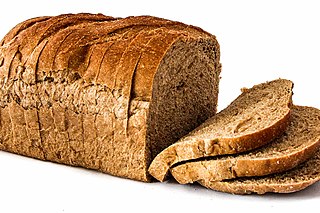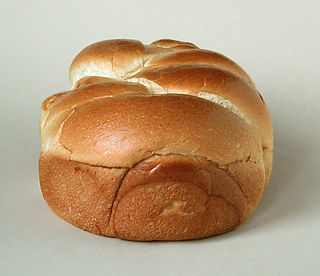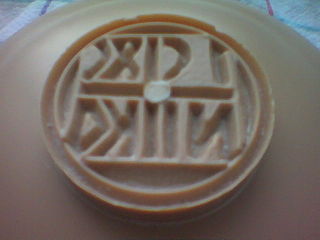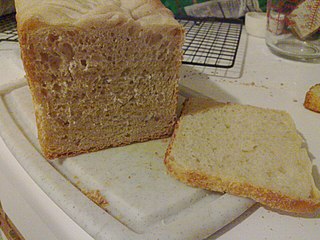
Sliced bread is a loaf of bread that has been sliced with a machine and packaged for convenience, as opposed to the consumer cutting it with a knife. It was first sold in 1928, advertised as "the greatest forward step in the baking industry since bread was wrapped". By 1933, around 80% of bread sold in the US was pre-sliced, leading to the popular idiom "greatest thing since sliced bread".

A baguette is a long, thin type of bread of French origin that is commonly made from basic lean dough. It is distinguishable by its length and crisp crust.

Brioche is a pastry of French origin whose high egg and butter content gives it a rich and tender crumb. The chef Joël Robuchon described it as "light and slightly puffy, more or less fine, according to the proportion of butter and eggs". It has a dark, golden, and flaky crust, frequently accentuated by an egg wash applied after proofing.

A sugarloaf was the usual form in which refined sugar was produced and sold until the late 19th century, when granulated and cube sugars were introduced. A tall cone with a rounded top was the end product of a process in which dark molasses, a rich raw sugar that was imported from sugar-growing regions such as the Caribbean and Brazil, was refined into white sugar.

A bread bowl is a round loaf of bread which has had the top cut off and a large portion of the middle hollowed out to create an edible bowl. They are typically larger than a roll but smaller than a full sized loaf of bread.

Pumpernickel is a typically dense, slightly sweet rye bread traditionally made with sourdough starter and coarsely ground rye. It is sometimes made with a combination of rye flour and whole rye grains.

A bread making machine or breadmaker is a home appliance for baking bread. It consists of a bread pan, at the bottom of which are one or more built-in paddles, mounted in the center of a small special-purpose oven. The machine is usually controlled by a built-in computer using settings input via a control panel. Most bread machines have different cycles for different kinds of dough—including white bread, whole grain, European-style, and dough-only. Many also have a timer to allow the bread machine to function without operator input, and some high-end models allow the user to program a custom cycle.

A prosphoron is a small loaf of leavened bread used in Orthodox Christian and Greek Catholic (Byzantine) liturgies. The plural form is prosphora (πρόσφορα). The term originally meant any offering made to a temple, but in Orthodox Christianity and Byzantine Rite Catholicism it has come to mean specifically the bread offered at the Eucharist during Divine Liturgy.

A loaf is a (usually) rounded or oblong quantity of food, typically and originally of bread. It is common to bake bread in a rectangular bread pan or loaf pan because some kinds of bread dough tend to collapse and spread out during the cooking process if not constrained; the shape of less viscous doughs can be maintained with a bread pan whose sides are higher than the uncooked dough. More viscous doughs can be hand-molded into the desired loaf shape and cooked on a flat oven tray.

Cuban bread is a fairly simple white bread, similar to French bread and Italian bread, but has a slightly different baking method and ingredient list ; it is usually made in long, baguette-like loaves. It is a staple of Cuban-American cuisine and is traditionally the bread of choice when making an authentic Cuban sandwich.

The Pullman loaf, sometimes called the "sandwich loaf" or "pan bread", is a rectangular loaf of white bread baked in a long, narrow, lidded pan. The French term for this style of loaf is pain de mie, or, less commonly, pain anglais.

Beer bread is any bread that includes beer in the dough mixture. Depending on the type of beer used, it may or may not contribute leavening to the baking process. Thus, beer breads range from heavy, unleavened, loaves to light breads and rolls incorporating baker's yeast. The flavor of beer bread is sometimes enhanced with other flavors, such as cheese or herbs.

A lame is a double-sided blade that is used to slash the tops of bread loaves in baking. A lame is used to score bread just before the bread is placed in the oven. Often the blade's cutting edge will be slightly concave-shaped, which allows users to cut flaps considerably thinner than would be possible with a traditional straight razor.

Vienna bread is a type of bread that is produced from a process developed in Vienna, Austria, in the 19th century. The Vienna process used high milling of Hungarian grain, and cereal press-yeast for leavening.
Parbaking is a cooking technique in which a bread or dough product is partially baked and then rapidly frozen for storage. The raw dough is baked normally, but halted at about 80% of the normal cooking time, when it is rapidly cooled and frozen. The partial cooking kills the yeast in the bread mixture, and sets the internal structure of the proteins and starches, so that the inside is sterile and stable, but the loaf has not generated "crust" or other externally desirable qualities that are difficult to preserve once fully cooked.
A pan loaf is a style of bread loaf baked in a loaf pan or tin. It is the most common style available in the United Kingdom, though the term itself is predominantly Scottish and Northern Irish so as to differentiate it from the plain loaf. The pan loaf has a soft pale brown crust all round the bread, in contrast to a plain loaf's darker crust only at the top and bottom.

A nut roast or roasted nut loaf is a vegetarian dish consisting of nuts, grains, vegetable oils, broth or butter, and seasonings formed into a firm loaf shape or long casserole dish before roasting and often eaten as an alternative to a traditional British style roast dinner. It is popular with vegetarians at Christmas, as well as part of a traditional Sunday roast. Nut roasts are also made by Canadian and American vegetarians and vegans as the main dish for Thanksgiving or other harvest festival meals.

Basler Brot, in Basel also Basler Laibli, is a bread traditionally made in the Swiss cantons of Basel-Stadt and Basel-Landschaft, but now popular in all of Switzerland. It is distinguished from other Swiss breads by a very soft, porous dough and a mealy, crunchy crust.
Bread is a staple food throughout Europe. Throughout the 20th century, there was a huge increase in global production, mainly due to a rise in available, developed land throughout Europe, North America and Africa.
















